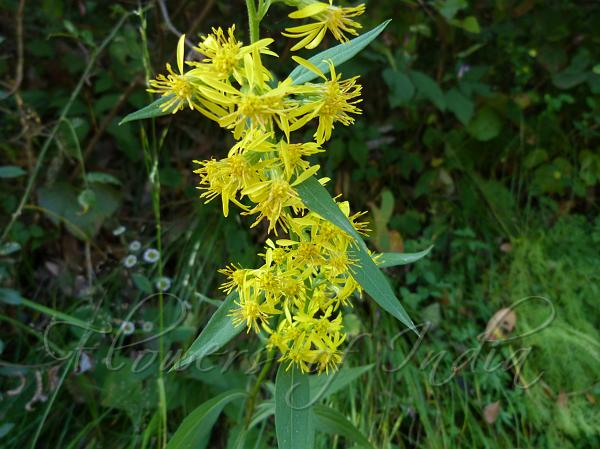|
| Himalayan Goldenrod |
|

|

| File size | 490305 |
| Original date | 10/25/12 10:11 AM |
| Resolution | 2048 x 1536 |
| Flash | Flash did not fire, auto |
| Focal length | 4.5mm |
| Exposure time | 1/60s |
| Aperture | 2.8 |
| Focus Distance | |
| Metering Mode | Multi-segment |
| Camera make | Panasonic |
| Camera model | DMC-FZ40 |
| Sensor type | OneChipColorArea |
|
|
|
|
Photo: |
Botanical name: Solidago virgaurea Family: Asteraceae (Sunflower family)
Synonyms: Aster virgaurea, Solidago virga-aurea, Solidago vulgaris
Synonyms: Aster virgaurea, Solidago virga-aurea, Solidago vulgaris
Himalayan goldenrod is a perennial often found along
roadsides and in open fields with single woody stems that grow to
heights of 3-7 ft. It has daisy-like flower-heads but ray florets short
and few (6-12). Flower-heads are about 8 mm across. Flower-heads occur
in a tight cylindrical panicle, not a broad flat or loose one like
Ragworts. Leaves may be toothed but are not lobed. Fruits is about 3 mm
long plus a 3 mm tuft of off-white hairs to aid wind dispersal.
Himalayan goldenrod is found throughout the Himalayas, from 1800-3800 m.
Flowering: July-September.
Medicinal uses:  This plant was cultivated in the Arab world, who used it in their
medical system. In the fifteenth and sixteenth centuries it was used in
Europe to heal wounds. It has astringent, diuretic, antiseptic and
other properties. Modern herbalists also use it to treat catarrh and
kidney stones. It is blended with other tonic herbs to cleanse or
"flush" the kidneys and bladder, either as part of a healing fast, or
to treat cystitis. In the case of a fast, it is made into a combined
tincture as noted, taken with a supporting blend of herbal teas, and
grape or watermelon juice is drunk through the day, alternating with
Potassium broth.
This plant was cultivated in the Arab world, who used it in their
medical system. In the fifteenth and sixteenth centuries it was used in
Europe to heal wounds. It has astringent, diuretic, antiseptic and
other properties. Modern herbalists also use it to treat catarrh and
kidney stones. It is blended with other tonic herbs to cleanse or
"flush" the kidneys and bladder, either as part of a healing fast, or
to treat cystitis. In the case of a fast, it is made into a combined
tincture as noted, taken with a supporting blend of herbal teas, and
grape or watermelon juice is drunk through the day, alternating with
Potassium broth.
 This plant was cultivated in the Arab world, who used it in their
medical system. In the fifteenth and sixteenth centuries it was used in
Europe to heal wounds. It has astringent, diuretic, antiseptic and
other properties. Modern herbalists also use it to treat catarrh and
kidney stones. It is blended with other tonic herbs to cleanse or
"flush" the kidneys and bladder, either as part of a healing fast, or
to treat cystitis. In the case of a fast, it is made into a combined
tincture as noted, taken with a supporting blend of herbal teas, and
grape or watermelon juice is drunk through the day, alternating with
Potassium broth.
This plant was cultivated in the Arab world, who used it in their
medical system. In the fifteenth and sixteenth centuries it was used in
Europe to heal wounds. It has astringent, diuretic, antiseptic and
other properties. Modern herbalists also use it to treat catarrh and
kidney stones. It is blended with other tonic herbs to cleanse or
"flush" the kidneys and bladder, either as part of a healing fast, or
to treat cystitis. In the case of a fast, it is made into a combined
tincture as noted, taken with a supporting blend of herbal teas, and
grape or watermelon juice is drunk through the day, alternating with
Potassium broth. | Identification credit: Gurcharan Singh | Photographed in Dhanaulti, Uttarakhand. |
• Is this flower misidentified? If yes,